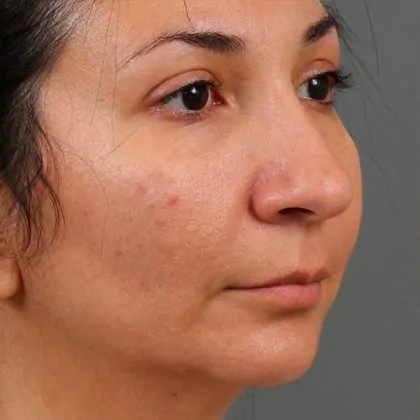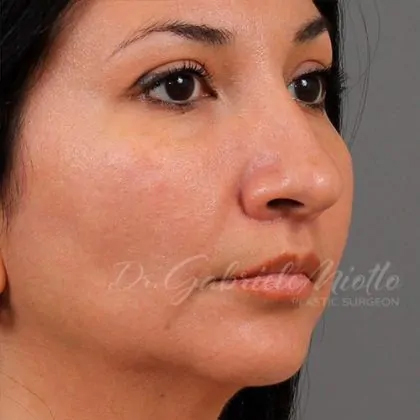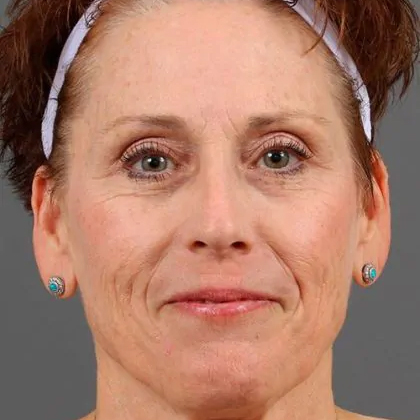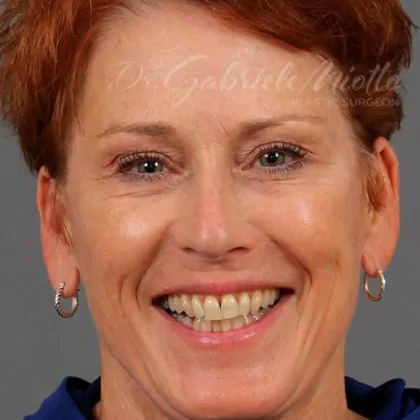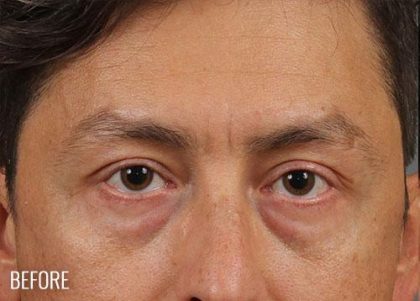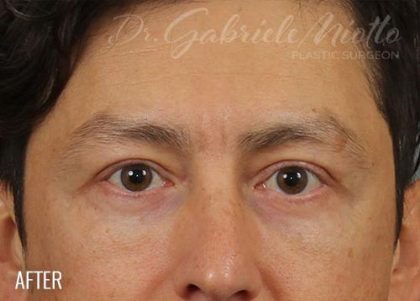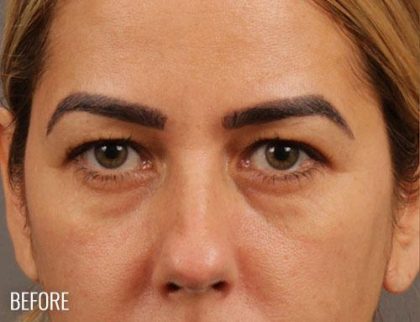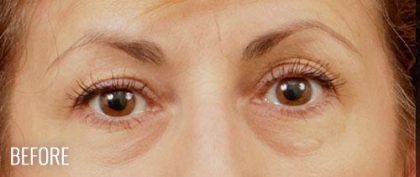Eye Bags Treatment
Conveniently located to serve the areas of Atlanta, GA
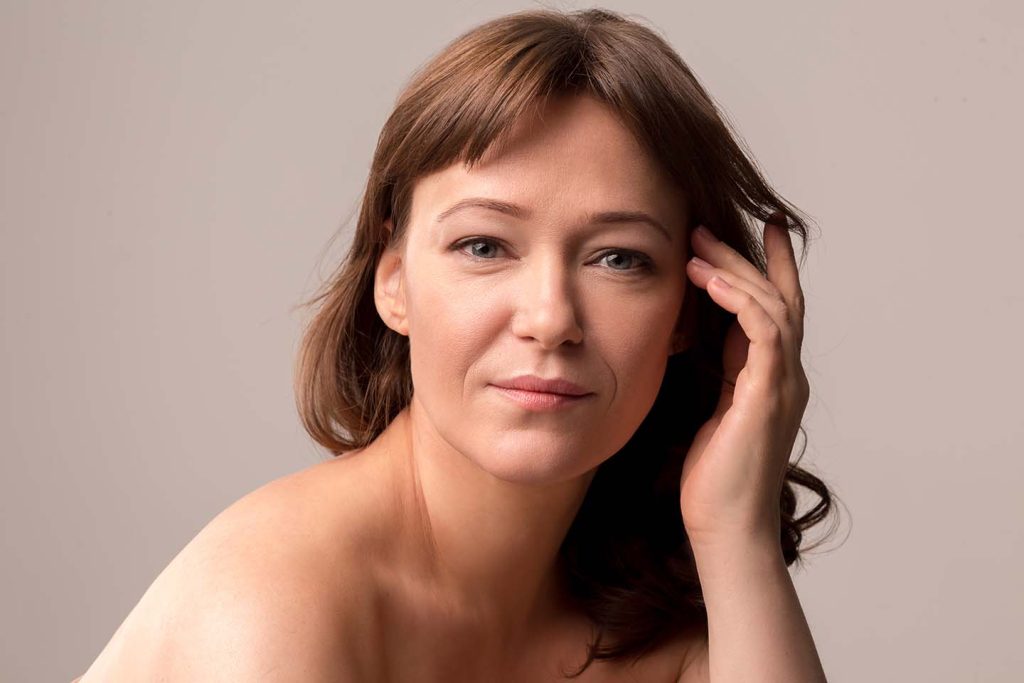
Lower eyelid surgery, which is also called a lower blepharoplasty, can be used to address a variety of issues affecting the lower eyelid, including under-eye bags. At ME Plastic Surgery in Atlanta Dr. Gabriele Miotto, who is an internationally recognized plastic surgeon and blepharoplasty specialist, performs a variety of procedures to address issues affecting the eyes. Among these procedures are skin-pinch blepharoplasty and lower eyelid surgery for eye bag treatment. The surgical treatment she recommends is based on the severity of the under-eye bags.
Contents
- 1 Before and After Photos
- 2 Patient story
- 3 Ideal candidate
- 4 Fat grafting
- 5 Consultation
- 6 Preparing
- 7 Post-surgical transportation policy
- 8 Pre-Treatment Restrictions
- 9 Pre-Surgery Medications
- 10 Procedure
- 11 Pre-op
- 12 Anesthesia is administered
- 13 Creating the incisions
- 14 Incision methods
- 15 The lash-line incision
- 16 The transconjunctival incision
- 17 The skin-pinch technique
- 18 The recovery room
- 19 Common side effects
- 20 Recovery expectations
- 21 Personal hygiene
- 22 Activity
- 23 Returning to Work
- 24 Diet
- 25 Results
- 26 Are there any other eye bag treatment options?
- 27 Before and After Photos
- 28 Potential risks
- 29 Potential risks include
- 30 Side effects
- 31 What does a lower blepharoplasty to treat eye bags cost?
- 32 Choosing a surgeon
- 33 FAQ
Before and After Photos
Patient story

This is a female patient in her 60’s who wanted to improve the tired look and puffiness in the upper and lower eyelids. We did an upper and lower blepharoplasty (eyelid surgery) to remove excess skin and bags and to tighten the eyelid muscles. We also restored the eyelid shape and brighteness with a lateral “scarless” brow lift and a eye corner lift, or canthopexy.
Ideal candidate
- is a nonsmoker or is willing to stop smoking at least 4 weeks before and then 4 weeks after his or her surgery.
- is in overall good health.
- does not have any of the medical conditions known to inhibit the body’s healing process.
- has realistic goals as well as a positive outlook.
- does not have a serious eye condition.
Additional procedures that can be performed at the same time as a lower blepharoplasty to address under-eye bags include
- An upper blepharoplasty.
- An endoscopic or lateral brow lift.
- A neck lift.
- A facelift.
- Laser skin resurfacing.
- A chemical peel.
- Fat grafting to fill in facial areas that have lost volume as well as to address hollowing beneath the eyes.
Fat grafting
Dr. Miotto removes the patient’s fat using liposuction, common areas for fat harvesting include the abdomen, hips and thighs. Once harvested, doctor processes the fat so she can attain the strongest cells for injection. These cells are strategically injected into areas that appear sunken-in or hollow.
Consultation
ME Plastic Surgery requests that patients arrive approximately 15 minutes before their scheduled appointment. During this initial consultation, Dr. Gabriele Miotto requests information about the patient’s medical history. Patients who have an extensive history may want to make a list to bring in with them on the day of their consultation.
Medical information Dr. Miotto needs includes
- current medications and the reason they are prescribed. Please include dosage amount and frequency.
- medical conditions.
- surgical procedures.
- medical treatments.
- allergies to medication and latex.
Dr. Miotto will ask the patient what he or she would like to accomplish with an eye bag treatment in Atlanta. Patients are encouraged to be candid with the doctor because the only way that Dr. Gabriele Miotto can assist the patient with reaching the aesthetic results that he or she desires is knowing what those desires are.
To determine if the patient is a good candidate for a lower blepharoplasty, a physical examination of the eyes is performed. During this exam, measurements may be taken and tear production might be checked. Once the evaluation is complete, the doctor has a good idea as to which procedure, or procedures, will accomplish the look the patient desires.
Dr. Gabriele Miotto makes her recommendations
The recommendations that Dr. Miotto makes may include lower eyelid surgery as an eye bag treatment, upper eyelid surgery to address any issues related to the upper eyelid (e.g., a drooping lid, etc.). If the patient decides to move forward with any cosmetic or surgical procedure, the doctor takes several photos of the areas that she will be treating. These pictures are taken from various angles and are used while creating the patient’s personalized surgical treatment plan.
During the initial consultation, Dr. Gabriele Miotto may outline the steps of the selected procedures. She may also discuss the patient’s anesthesia options. At ME Plastic Surgery in Atlanta patients are encouraged to ask questions because ensuring that each patient feels comfortable and informed about the procedure he or she is about to have is very important to Dr. Miotto.
Preparing
Before having a lower blepharoplasty with plastic surgeon and blepharoplasty specialist Dr. Gabriele Miotto, patients need to follow the instructions below.
Patients who are having pre-surgical testing done need to complete these tests no later than 7 days before their procedure. This allows enough time for Dr. Miotto to receive the results. If she does not receive these results in time, the patient’s procedure may need to be rescheduled.
Post-surgical transportation policy
Following surgery, patients are unable to drive themselves home and ME Plastic Surgery has a policy in place that restricts patients from using any of the public or for-hire services that are available. This policy was created to ensure that our patients remain safe as they head home after their procedures. As such, patients need to ask a physically capable adult who is a licensed driver to bring them to and take them home from their eye bag treatment in Atlanta. A physically capable adult is someone who can assist the patient with walking.
Patients need to have a caregiver for the first 24 hours after surgery
Additionally, for the safety of her patients, Dr. Miotto requires that her patients have someone remain with them for the first 24 hours following surgery. She requires her patients to have a caregiver because the medications used during surgery (e.g., general anesthesia, etc.) are designed to affect the nervous system directly, therefore, some patients experience judgement and balance issues for some time afterwards. Having another adult present to assist the patient as he or she walks reduces the likelihood of a fall.
Patients are unable to drive for a full 24 hours after their surgery, therefore, patients need to ask someone they trust to drive them to and from their first follow-up appointment with Dr. Gabriele Miotto the day after their eye bag treatment. Furthermore, patients who are taking narcotic pain medication are not permitted to drive until they no longer need this type of medication.
Pre-Treatment Restrictions
4 weeks before and 4 weeks after surgery
Using products that contain nicotine inhibit the body’s ability to heal itself, therefore, patients must stop using nicotine-containing products (e.g., cigarettes, nicotine gum, chewing tobacco, etc.) at least 4 weeks before and 4 weeks after their eye bag treatment.
Patients who continue to use these products increase their likelihood of experiencing a complication after surgery. Potential complications include open wounds that neglect to heal, infection and even necrosis (i.e., tissue death). In addition, besides being an unhealthy habit, individuals who smoke cigarettes or spend a lot of time around second-hand smoke tend to show the signs of aging faster than those who do not.
10 days before surgery
Stop taking Vitamin E and do not take any of the following herbal supplements: Ephedra / Phentermine (weight loss drug), Echinacea, Fish Oils, Feverfew, Ginkgo Biloba, Garlic, Kava-Kava, Goldenseal, Saw Palmetto, Licorice, Valerian and St. John’s Wort.
From 7 to 10 days before surgery
Patients must not take aspirin or any other medication that thins the blood as this could cause unnecessary bleeding, however, patients who have been prescribed blood thinners or aspirin should speak with the prescribing physician, their general practitioner or Dr. Miotto before discontinuing any prescription medication regimen.
7 days before surgery
Alcohol can increase inflammation, therefore, 7 days before surgery patients must avoid drinking alcoholic beverages.
5 days before lower eyelid surgery for eye bags in atlanta
Patients must not take any nonsteroidal anti-inflammatory drugs (NSAIDs). These drugs include ibuprofen, Motrin and Aleve.
What patients can take for pain relief
Patients who need to take pain relief medication during the 10 days leading up to surgery can use acetaminophen, aka Tylenol.
Questions about medication
Patients who have questions about any of the medications they take need to contact ME Plastic Surgery at (404) 850-5851 to speak with one of Dr. Miotto’s nurses.
Pre-Surgery Medications
Starting 5 days before surgery
Chemical peel and laser treatment patients – 14 days before surgery: hydroquinone and retin-a
Patients who are adding a laser treatment or a chemical peel to their lower blepharoplasty surgical session need to start taking hydroquinone and retin-a (tretinoin) about 14 days before their scheduled procedure. These products help the body heal faster. Patients can find both these revolutionary facial products at our Spa.
Procedure
Patients need to arrive approximately 15 minutes before their scheduled appointment time. Since patients are unable to drive following surgery and our transportation policy forbids the use of for-hire transportation after surgical procedures, patients who arrive without a driver will need to reschedule their eye bag treatment.
Pre-op
While the patient is being prepped for surgery by our medical team, Dr. Gabriele Miotto usually visits the patient. She may make several markings in the areas of the face being treated. These markings help guide her during surgery. Patients are encouraged to ask any last-minute questions they have about their lower blepharoplasty or any other procedure they are having during the same surgical session.
Anesthesia options are discussed with the patient prior to his or her Atlanta eye bag treatment. Dr. Miotto performs surgery while her patient is resting comfortably with oral sedation and local anesthesia or IV sedation.
Anesthesia is administered
Before the surgery begins, the patient is anesthetized.
Creating the incisions
There are two incision methods that can be used during a lower blepharoplasty in Atlanta, the lash-line incision or the transconjunctival incision. While creating the patient’s surgical treatment plan, Dr. Gabriele Miotto determines which method will serve the patient better. Incision placement is discussed with the patient prior to surgery.
Incision methods
A lower blepharoplasty for eye bag treatment in Atlanta usually takes about an hour, however, patients having multiple procedures should expect to remain in surgery longer.
The lash-line incision
The lash-line incision – the surgeon creates the incision along the eyelash margin. Through this incision, fat is removed. The excess skin is carefully cut away and fine sutures are used to close the incision, as the incision is closed, the eyelid is lifted. Patients usually return to have these sutures removed about seven days after their surgery.
Although the lash-line incision is visible following surgery, this line fades relatively quickly. Since excess skin is removed with the lash-line incision, the transition from the lower eye to the cheek is smoother.
The transconjunctival incision
The transconjunctival incision – Dr. Miotto creates an incision just inside the lower eyelid. She removes the fat deposits. When this incision method is used, sutures are not necessary.
The skin-pinch technique
This procedure takes about 45 minutes.
When a patient’s eye bags are minor and fat has not accumulated beneath the eye, Dr. Miotto may recommend that the patient have the skin-pinch eye bag removal surgery.
During this procedure, Dr. Gabriele Miotto simply pinches the outer corner of the patient’s eye to determine how much skin she should remove. The incision for this surgery is created at the outer corner of the eye which ensures the resulting scar (although very small) remains hidden within the natural creases of the eyelid. Dr. Miotto removes the excess skin and then closes the incision with very fine sutures. The patient returns to ME Plastic Surgery in Atlanta about a week after their procedure to have the sutures removed.
The recovery room
Patients will remain in the recovery room until they are fully awake and Dr. Gabriele Miotto is satisfied with their initial post-surgical progress. Upon waking the patient may have lubricating ointment and cool compresses covering his or her eyes. The ointment keeps the eyes moist and the cool compresses help reduce inflammation and minimize bruising.
Before the patient leaves, ME Plastic Surgery’s Patient Care Coordinator schedules the follow-up appointment for the patient, which will be the very next day.
Patients receive information explaining how they should care for their eyes, informing them of their restrictions and outlining common side effects following surgery for eye bag treatment in Atlanta. Before heading home, patients should feel free to ask any questions they have about recovery. Once all the patient’s questions are answered and recovery information is received, the patient is released to his or her driver.
Patients must have someone remain with them for at least the first 24 hours following their lower eyelid surgery.
Common side effects
Some of the most common temporary side effects patients experience following eye bag surgery include
- Double vision.
- Watery eyes.
- Dry eyes.
- Inflammation.
- Bruising.
- Blurry vision.
- Light sensitivity.
- Discomfort.
- Eyelids that feel numb.
- Puffy-looking eyelids.
Recovery expectations
Since patients taking narcotic pain medication cannot drive until they no longer need it, they must find someone to bring them to and take them home from their follow-up appointments.
Patients should use two or three pillows to keep their head higher than their heart while sleeping. This helps reduce inflammation.
Feeling tired for several days after surgery should be expected. The anesthesia that is used during surgery is one of the main reasons for this sluggishness, therefore, as these medications exit the body, the patient will begin to feel more awake.
Personal hygiene
- Patients are permitted to shower 24 hours post-op.
- Although patients can safety have soapy water run over their incision sites, these sites must not be rubbed or scrubbed. Patients need to follow the instructions they received for properly cleaning their surgical sites from Dr. Miotto or a member of her medical staff before they left the recovery room.
- Lotions should not be applied to the incision sites for at least 2 weeks; however, patients can safely moisturize other areas of their body.
- Until all the incision sites have healed completely, which typically takes about 3 weeks, patients must refrain from submerging themselves while in a bathtub, pool or hot tub, etc.
Activity
After having anesthesia, especially general anesthesia, immobility could result in the development of a post-operative blood clot. For this reason, bed rest is not recommended following any surgical procedure that requires the use of anesthesia. Nonetheless, for 14 days after surgery patients must avoid performing physical activities that could increase their blood pressure and heart rate, instead patients should walk around at their normal pace. To prevent blood-clot formation, patients need to begin walking shortly after surgery.
After 7 to 14 days have passed, patients can resume their normal sexual activity.
Patients who have concerns about their recovery should feel free to speak about them with Dr. Gabriele Miotto.
Returning to Work
During the first week of recovery patients realize their limitations, which helps them determine their comfort level in relation to returning to work and resuming their daily activities. Most of Dr. Miotto’s patients are ready to return to work within 7 to 14 days of their eye bag treatment in Atlanta.
Diet
Directly after surgery patients should stick to a bland diet with minimal salt and sugar. Their diet needs to be filled with foods that the body can easily digest.
Easily digestible foods include: eggs, nuts, beans, lean meats and any of the other healthy proteins. In addition, patients should eat various fruits (e.g., avocado, very ripe bananas and cantaloupe etc.), white rice, tofu, white pasta and cooked vegetables (e.g., sweet potatoes, broccoli, carrots and pumpkin, etc.). These foods provide the body with the nutrition it needs as it heals.
Some pain medications are known to cause nausea; therefore, patients should always eat a couple bites of food before they take this type of medicine.
Staying well hydrated by drinking water, protein shakes and sports drinks that are low in sugar helps to move nutrients throughout the body quicker so they can aid the body as it heals as well as rid the body of toxins and the anesthesia medications that remained in the body following surgery.
Results
Dr. Gabriele Miotto follows her patients’ progress as they recover. She wants them to have an uneventful recovery so they can heal well and have beautiful, natural-looking results.
After about 12 weeks, most patients can expect their results to be permanent, nevertheless for some patients, improvement continues for several months.
Patients frequently experience subtle changes in the way their scars look and the amount of inflammation they have. These changes can continue for up to 12 months.
Open communication between Dr. Gabriele Miotto, her team and the patient are key to a smooth and uneventful recovery. As such, if patients have a question or a concern, they should not hesitate to contact ME Plastic Surgery at (404) 850-5851 to speak with Dr. Miotto or a member of her team.
Are there any other eye bag treatment options?
Yes, at ME Plastic Surgery in Atlanta, there are several procedures that can be used to reduce the visibility of under-eye bags. These procedures include microneedling, injectable fillers, laser treatments and chemical peels. Although these procedures are less invasive, many patients opt for a lower blepharoplasty to treat their under-eye bags because the results achieved with a lower blepharoplasty offer them longevity, sometimes lasting a lifetime.
Before and After Photos
Dr. Gabriele Miotto enjoys viewing her patients’ pre-op and post-op pictures with them. Watching her patients’ excitement helps her realize how glad she is to be a plastic surgeon who is helping people attain the more youthful-looking, refreshed appearance they desire.
Potential risks
As is true with every surgical procedure there are risks, however, choosing an experienced plastic surgeon specializing in blepharoplasty procedures greatly reduces the likelihood of a complication after eye bag treatment.
Potential risks include
- Inflammation.
- Bruising.
- Dry eyes.
- Bleeding.
- An infection.
- Sensitivity to light.
- Problems closing the eyes all the way.
- The usual anesthesia risks (e.g., blood clots, reaction to the medications, etc.).
- Ectropion, a lower eyelid that pulls down or lid lag. These issues are typically temporary.
- Vision changes (temporary or permanent).
- Visible scarring.
- Pain (temporary or permanent).
- Blindness, which is an extremely rare complication (temporary or permanent).
Side effects
Patients experiencing any of the side effects listed below need to seek medical treatment.
- Difficulty seeing (please keep in mind that blurry vision should be expected when lubricating ointment is in the eyes).
- Chest pain.
- Shortness of breath.
- Bleeding.
- Heart arrhythmia (i.e., the heart beats too slow, too fast or irregularly).
- The onset of new, severe eye pain.
What does a lower blepharoplasty to treat eye bags cost?
Treatment costs vary and can only be determined during an initial consultation. Individuals who are considering eye bag treatment should make an appointment with plastic surgeon and blepharoplasty specialist Dr. Gabriele Miotto.
Choosing a surgeon
Surgeon selection is extremely important because the skill and knowledge of the surgeon directly affect the final result. For example, when it comes to lower eyelid surgery, an inexperienced surgeon may remove unequal amounts of fat from beneath the eyes, resulting in under eye areas that appear unbalanced. If the surgeon removes too much skin, the patient’s eyes may look too tight or uneven. For most patients, these surgical errors require corrective surgery.
When choosing a plastic surgeon to perform your surgical eye bag treatment in Atlanta, be sure the surgeon you choose either has extensive experience performing blepharoplasties or specializes in performing these procedures.
At ME Plastic Surgery Internationally Recognized Plastic Surgeon and Blepharoplasty Specialist Dr. Gabriele Miotto performs surgical and non-surgical treatments to address under-eye bags. If you reside in or around Atlanta, or you plan to visit the area and you are interested in eye bag treatment, contact ME Plastic Surgery. To schedule your appointment today call (404) 850-5851. ME Plastic Surgery is in Atlanta, our address is 3200 Downwood Cir, NW. We are on the 6th floor in Suite 640.
FAQ
Who should consider having an eye bag treatment in atlanta?
Eye bag development is a relatively common occurrence, however, since these bags tend to make an individual appear tired, worn-out and unwell, many people decide to consult with a plastic surgeon to determine the best way to address these unwanted facial characteristics. Anyone who is experiencing inflammation, sagging or bloating beneath the eyes may want to consider learning more about the eye bag treatment options that are available.
At ME Plastic Surgery, Dr. Miotto performs lower eyelid surgery to remove excess skin beneath the eye. After she removes this excess skin, the lower eyelid is lifted. Moreover, the removal of this skin also eliminates the fine lines and wrinkles that this surplus of skin created. In addition, while performing a lower blepharoplasty for eye bag treatment, Dr. Gabriele Miotto removes the fat deposits that have settled beneath the eye, thus, eliminating the excess volume that causes an individual to appear tired or ill.
Patients who have very little fat beneath their eyes may be good candidates for a skin-pinch blepharoplasty at ME Plastic Surgery in Atlanta.
What causes under-eye bags to develop?
Eye bags are a relatively common skin condition. Although eye bag development can indicate that an individual has some kind of underlying condition (e.g., Graves’ disease, etc.) this is extremely rare. Under-eye bags frequently develop as part of the natural aging process, however, there are certain circumstances that increase the likelihood an individual will develop under-eye bags sooner rather than later.
Eye bags can develop due to:
Age – with age, the muscles around the eyes weaken, which allows fat and fluids to enter the lower eyelid area, resulting in the added volume that causes the area beneath the eye to bulge. The fat and fluid moving around within the lower eyelid causes the undereye area to appear puffy and inflamed. In addition, reduced collagen production, which is a normal part of the aging process, causes the skin to lose its elasticity. This loss of elasticity allows the skin beneath the eye to sag.
Genetics – eye bags tend to run in families. Individuals who notice that their blood relatives have under eye bags are more prone to developing them.
Allergies – people who live in the Atlanta area and have allergies that cause sinus or nasal congestion can develop puffiness around their eyes. Also, congestion can lead to pooling of the blood in the capillaries beneath the eyes, causing dark circles and inflammation. These eye characteristics are frequently referred to as allergic shiners.
Lifestyle choices – smoking cigarettes, poor sleeping habits and high salt intake can all contribute to the development of eye bags.
Keeping contacts in for too long – leaving contacts in longer than recommended can affect the amount of oxygen that is reaching the eye. If the eye is lacking oxygen, the cornea may become inflamed resulting in puffy-looking eyes. When it comes to eye health, the only contacts that are acceptable to sleep in are the extended-wear.
Other causes of puffy-looking eyes include:
– Infections.
– Fluid retention.
– Eye fatigue.
– Crying.
– Excessive alcohol consumption.
– Stress.


